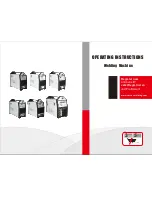
1
Introduction
Page 6
Stud welding unit
operating manual
Date:
July 2021
ALPHA 850
07.2021 / EN
Rev.:
A
1.7 Material combinations
The material combinations listed in the table below have already been tested. The
weld angle for the material combinations is defined as follows:
a = suitable for any application, such as force transfer,
b = suitable with limitations for force transfer,
c = suitable with limitations only for heat transfer,
–
= cannot be welded.
Explanation of superscript numbers:
1)
Up to 10 mm diameter and shielding gas in tub position (PA),
2)
Only during short cycle stud welding with drawn arc,
3)
Maximum yield strength R
eH
≤ 460 N/mm
2
.
Material
combination
Base material
EN ISO 15614-1
*)
Groups 1 and 2
3)
EN ISO 15614-1
*)
Groups 3 and 4
EN ISO 15614-1
*)
Group 9
EN ISO 15614-2
*)
Groups 21 and 22.1
Stud
S 235
4.8 (weld suitable)
16 Mo 3
a
b
b
2)
–
X 10 CrAl 18
X 10 CrAl 24
X 10 CrNiSi 25-4
c
c
c
–
1.4301, 1.4303
1.4401, 1.4451
1.4571
b (a)
1)
b
a
–
EN AW-AlMg 3
EN AW AlMg 5
–
–
–
b
Group 1:
Steels with minimum yield stress of R
eH
≤ 360 N/mm
2
Group 2:
Standardized or thermodynamically treated fine-grain structural steels
with a minimum yield stress of R
e
> 500 N/mm
2
Group 3:
Annealed fine-grain structural steels with a minimum yield stress of
R
e
> 500 N/mm
2
Group 4:
Steels with Cr max. 0.75%, Mo max. 0.6%, V max. 0.3%
Group 9:
Austenitic stainless steels
Group 21:
Pure aluminium with max. 1.5% impurities
Group 22.1: Non-
curable AlMg alloys with ≤3.5% Mg content
For material combinations that are not listed in the table, a Tucker expert must be
consulted.
*)
EN ISO 15614-1, 2: Specification and qualification of welding procedures for metallic materials – Welding
procedure test












































